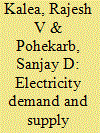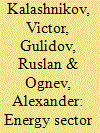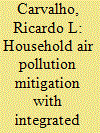|
|
|
Sort Order |
|
|
|
Items / Page
|
|
|
|
|
|
|
| Srl | Item |
| 1 |
ID:
132592


|
|
|
|
|
| Publication |
2014.
|
| Summary/Abstract |
Forecasting of electricity demand has assumed a lot of importance to provide sustainable solutions to the electricity problems. LEAP has been used to forecast electricity demand for the target year 2030, for the state of Maharashtra (India). Holt's exponential smoothing method has been used to arrive at suitable growth rates. Probable projections have been generated using uniform gross domestic product (GDP) growth rate and different values of elasticity of demands. Three scenarios have been generated which include Business as Usual (BAU), Energy Conservation (EC) and Renewable Energy (REN). Subsequent analysis on the basis of energy, environmental influence and cost has been done. In the target year 2030, the projected electricity demand for BAU and REN has increased by 107.3 per cent over the base year 2012 and EC electricity demand has grown by 54.3 per cent. The estimated values of green house gas (GHG) for BAU and EC, in the year 2030, are 245.2 per cent and 152.4 per cent more than the base year and for REN it is 46.2 per cent less. Sensitivity analysis has been performed to study the effect on the total cost of scenarios. Policy implications in view of the results obtained are also discussed.
|
|
|
|
|
|
|
|
|
|
|
|
|
|
|
|
| 2 |
ID:
110352


|
|
|
|
|
| Publication |
2011.
|
| Summary/Abstract |
This article describes the Russian Far East's energy sector, stressing its limited energy exports, and use of separate electricity and heating grids to geographically dispersed population centers with various supply patterns distributed across a vast territory. One key strategic trend has been to strengthen the potential of the region as an energy supplier for the countries of Northeast Asia. This underlies the framework used to develop three energy scenarios of the Russian Far East's energy future through 2030: Reference, National Alternative and Regional Alternative. While the Regional Alternative case has much greater total costs for implementation, yields almost the same amount of emissions as the BAU case, and requires greater governmental efforts to bring it to reality, it looks preferable for the RFE as a whole because it has a well-balanced primary energy consumption mix, lower energy and ecology/GDP indices, and a lower fraction of energy imports; offers greater diversity of energy supply; and provides better local energy service. The authors would like to thank Boris Saneev, Alexander Sokolov, Alexander Izhbuldin from the Institute of Energy Systems, Irkutsk; Julia Savelieva from Far Eastern Coal Research; and Alla Filatova from Far Eastern Power Engineering Institute for providing technical information, and expertise.
|
|
|
|
|
|
|
|
|
|
|
|
|
|
|
|
| 3 |
ID:
166720


|
|
|
|
|
| Summary/Abstract |
Traditional cooking is today's largest global environmental health risk. Over 640 million people in Africa are expected to rely on biomass for cooking by 2040. In Kenya, cooking inefficiently with wood and charcoal persists as a cause of deforestation and household air pollution. This research analyses the effects of four biomass cookstove strategies on reducing air pollutant emissions in Kisumu County between 2015 and 2035 using the Long-Range Energy Alternatives Planning system. The Business as Usual scenario (BAU) was developed considering the historical trends in household energy use. Energy transition scenarios to Improved Cookstoves (ICS), Pellet Gasifier Stoves (PGS) and Biogas Stoves (BGS) were applied to examine the impact of these systems on energy savings and air pollution mitigation. An integrated scenario (INT) was evaluated as a mix of the ICS, PGS and BGS. The highest energy savings, in relation to the BAU, are achieved in the BGS (30.9%), followed by the INT (23.5%), PGS (19.4%) and ICS (9.2%). The BGS offers the highest reduction in the GHG (37.6%), CH4 (94.3%), NMVOCs (85.0%), CO (97.4%), PM2.5 (64.7%) and BC (48.4%) emissions, and the PGS the highest reduction in the N2O (83.0%) and NOx (90.7%) emissions, in relation to the BAU.
|
|
|
|
|
|
|
|
|
|
|
|
|
|
|
|
| 4 |
ID:
105765


|
|
|
|
|
| Publication |
2011.
|
| Summary/Abstract |
Scientific studies have repeatedly shown the need to prevent the increase in global emissions so that the planet's average temperature does not exceed 2 °C over pre-industrial levels. While the divisions between Annex 1 and non-Annex nations continue to prevent the realization of a comprehensive global climate treaty, all members of the G-20 (incidentally also major emitters) have agreed to prevent the rise in global temperatures above 2 °C. This requires that nations consider budgeting their carbon emissions. India presents a unique case study to examine how a major emitter facing a desperate need to increase energy consumption will meet this challenge. The Greenhouse Development Rights (GDR) framework, perhaps considered the most favorable with respect to the responsibility and capacity of India to reduce emissions, was used to explore India's emissions trajectory. India's emissions have been pegged to the pathway required to meet the 2 °C target by non-Annex countries. The results have been compared to the expected emissions from 11 energy fuel mix scenarios up to the year 2031 forecasted by the Planning Commission of India. Results reveal that none of the 11 energy scenarios would help India meet its emissions target if it were to follow the 2 °C pathway. A thought experiment is followed to explore how India may meet this target. This includes a sensitivity analysis targeting coal consumption, the biggest contributor to India's emissions.
|
|
|
|
|
|
|
|
|
|
|
|
|
|
|
|
|
|
|
|
|